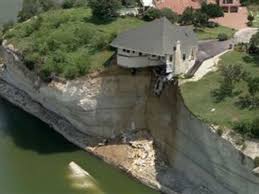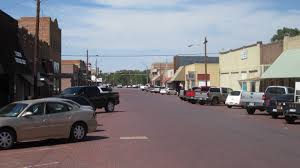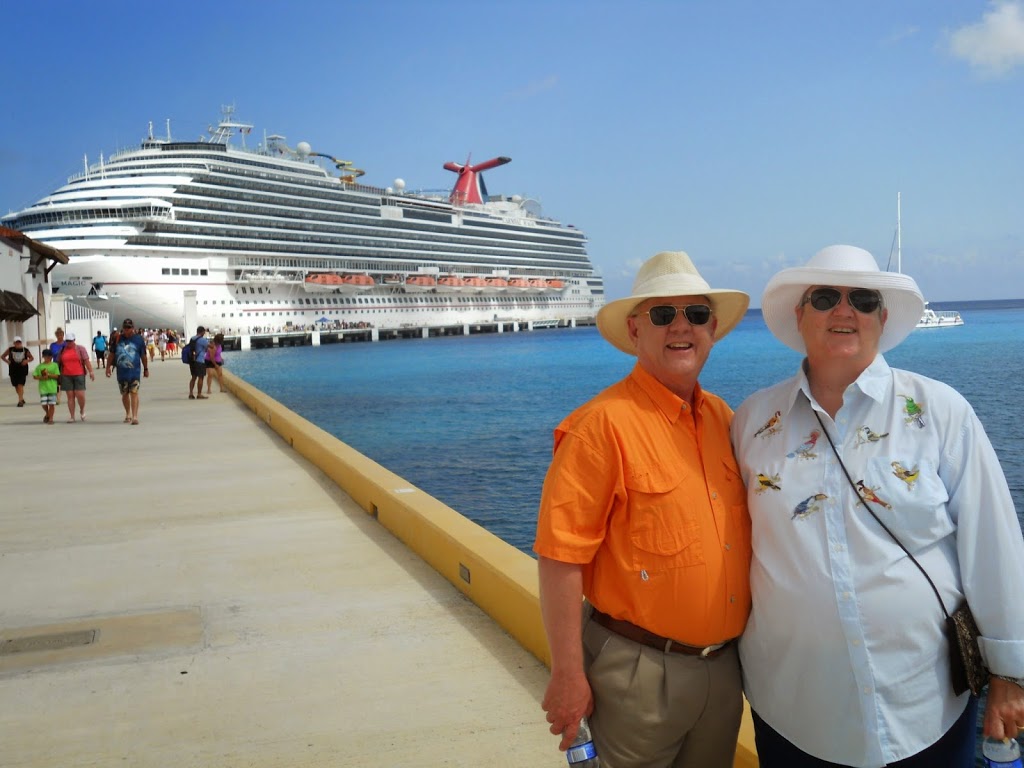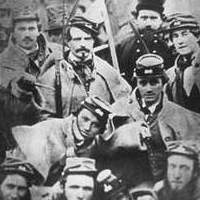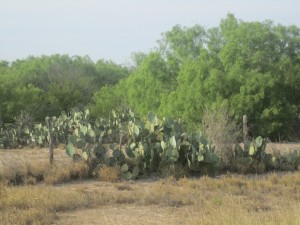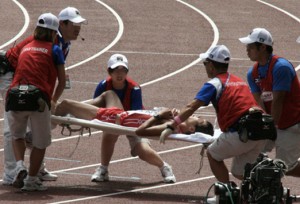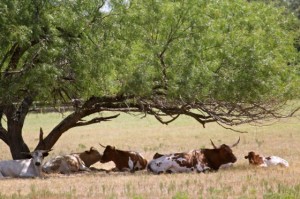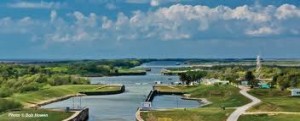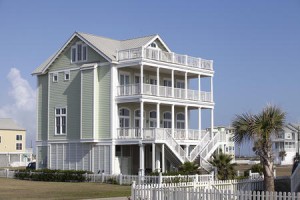I have lived in small Texas towns for the past thirty-plus (30+) years. I married the fella before he finished his Master’s degree and we moved to the town of Hillsboro, Texas, shortly after our first anniversary. At that time, Hillsboro still had a population of less than 10,000. All of Hill County had a population of right around 30,000. We lived there about three years and moved to Whitney on the west side of the county when our daughter was a year old. The actual town of Whitney is less than half the size of Hillsboro, but since the Whitney dam was built on the Brazos River back in the 1960s to control flooding downstream in Waco, people have moved into homes all along the lake, (Remember that house on the cliff that fell into the lake? That was on Lake Whitney), so the Whitney area population is much larger than just the town. The Whitney school district is close to the same size as Hillsboro, and in fact, the two schools are big football rivals. We lived in Whitney until our daughter got married, when she was 20.
And when we left Whitney, we moved to Clarendon, up in the Texas Panhandle. Clarendon was less than half the size of Whitney–population just under 2,000 when the junior college was not in session and just over, when it was. But Donley County is not on an Interstate highway, nor is it in the heavily trafficked “Golden Triangle” (Dallas/Fort Worth-Austin/San Antonio-Houston). It is on the main four-lane divided highway from Fort Worth to Amarillo and the mountains beyond (honestly, US 287 is the main drag for DFW residents to go snow skiing), which is why it’s surviving as well as it is. Plus it has that junior college and a little lake a few miles north of town. (Remember, all lakes in Texas are man-made. In this case, they dammed up the Salt Fork of the Red River.) We left the Panhandle for the Gulf Coast–still in Texas–about 7-1/2 years ago to live in a town of just under 50,000 (since Hurricane Ike), which in many places might be called a small town. After the places I’ve lived, I was thrilled to move to a town that had a Wal-Mart AND a Target. And even a Home Depot!
I am telling you all this so that you know that I know what I’m talking about when I talk small towns in Texas. I’ve lived there. I think I’ve driven through half of them. Well, maybe not half, but a bunch! How many of you can say they’ve driven through Idalou, Floydada (pronounced Floy-DAY-da), and Old Dimebox? How many of you know where they all are? Then there’s Matador, where my parents were married, and Cut-and-Shoot, which I’ve never been to, but I love the name, and Clemville, where my mama lived as a little girl during the Great Depression. I’m not sure Clemville is even a town, these days.
Anyway. Most small towns in Texas don’t have a lot of money. The people tend to be school teachers or small business owners or farmers and ranchers. Those folks usually have enough money to get by, live in a pretty nice house, etc., but generally, they aren’t going to be rich. And a lot of the people in a small town are going to be poor. Really poor. The rural poor tend to be both poorer and richer than the urban poor. Social services are much, much less available. There is 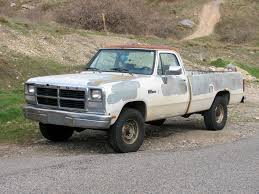 zero public transportation. But, they can plant gardens to help feed themselves. Then again, tools and seed cost money and a lot of them don’t have enough to buy a rake or a shovel. Transportation is the important thing.
zero public transportation. But, they can plant gardens to help feed themselves. Then again, tools and seed cost money and a lot of them don’t have enough to buy a rake or a shovel. Transportation is the important thing.
Also, in these small towns, the nice brick houses and the houses built of cinder blocks and plywood might be only a few vacant lots apart. The poor kids and the rich kids go to the same school, because there is only one school. One elementary, one junior high, one high school. There can be an “across the railroad tracks” or “living on the wrong side of the tracks” mentality, but often, if they’re good kids who participate at school, it’s not a given.
Whitney and Hillsboro both are about 30 miles from Waco (which is about 200,000 in population. It is as big as Buffalo, NY, or Pittsburgh, PA. Yes. It is.) and Clarendon is about 60 miles from Amarillo (which also has about 200,000 population. Yes, Amarillo, TX, is as big as Pittsburgh, PA.). Of those three towns, only Hillsboro was considered big enough for its own Wal-Mart. I think it got a Super Wal-Mart because it’s on I-35 where I-35E to Dallas and I-35W to Fort Worth split, or come together again, depending on whether you’re going north or south. To some extent, the number of stores and restaurants in a small town and the health of those businesses depends on its distance from a larger city. If it’s just as easy to run in to Waco as to drive over to Hillsboro, guess where the people are going to go? Because Waco has more stores.Highways also contribute. Hillsboro only got a McDonald’s because it’s on that Interstate. Clarendon has a Dairy Queen. But when DQ was closing stores across Texas, Clarendon and Quanah got to keep theirs and other towns didn’t. Because both towns are on US 287.
Generally, the stores that are going to thrive in a small town are going to be more general, and in most small Texas towns, at least half the store fronts will probably empty. Some towns–Calvert, on Texas Highway 6 between College Station and Waco, for instance–have almost all of their stores totally shut down. But in most towns, you’re going to have a pharmacy. Maybe two. If the town is big enough, the pharmacy will have more than just the drug dispensary at the back. If it’s not, the pharmacy might be tucked into the back of a gas station. There will probably be a video/DVD rental place, maybe stuck onto another business, for the people who can’t do Netflix or buy their own DVDs.
There will probably be a homegoods type store. In Clarendon, it had housewares on one side of a divider wall and auto parts, tires, and hardware on the other. The housewares included china, crystal, and a wedding registry. There will likely be a clothing store. Again, the store might be part of a store that sells something else, or it might be standalone, but it will probably sell everything from Dickie’s work coveralls to baby clothes to nice ladies’ dresses. There will be a “dollar store” of some kind, and a ranch and feed store. But unless your small town is a big tourist town–and I’m talking hordes of people–a small specialty boutique is not going to survive. The more kinds of things a store can sell, the more  likely it will stay in business. A bakery might be hard put to do it, unless it’s on a highway and has a gas station attached. (There are a lot of those, and they make some mighty good kolaches.)
likely it will stay in business. A bakery might be hard put to do it, unless it’s on a highway and has a gas station attached. (There are a lot of those, and they make some mighty good kolaches.)
(Okay, a break for an “only in Texas” moment. My son and I were driving along Broadway in Galveston not long after we moved–before the hurricane–and we passed a store with a sign that read “Donuts. Burritos. Kolaches.” He burst out laughing, because is there anywhere else in the U.S. besides Texas where those three things go in the same shop? Oh, and the owners of Broadway Donuts were actually Greek and made the best baclava to go with the burritos and kolaches…)
I have not been to a small town that had a surviving YMCA. A lot of them have old buildings that used to be a Y, but not any that are currently under operation. In Clarendon, the old YMCA building has been turned into City Hall. Very few have a movie theater, and those that do have one, it’s generally a drive-in. Remember, warm weather lasts from March through October, at least, in most of Texas, and even on Midsummer’s Day, the sun goes down before 10 p.m. There are a lot of still operating drive-in theaters in rural Texas.
 As far as restaurants and bars go, there will probably be a few. Might be a mom-and-pop home-cooking-type diner. There will probably be a Dairy Queen, or its ilk. There might be a taqueria or some kind of Mexican food place. (Tex Mex is a legitimate cuisine and don’t let anybody tell you it’s not “real Mexican food.” It’s border cooking.) If the food is good, though, people will come to eat it, whatever kind of place it is. Hillsboro had a Chinese restaurant, Kim Son, in a converted laundromat. Don’t know if it’s still there, but it did a big business. Hillsboro supports quite a few restaurants–but it’s on an Interstate. Whitney had surprisingly few places to eat in town, and even around the lake, when we lived there. It had a Dairy Queen and another burger place, and that was pretty much it. There was a Mexican restaurant for a while that was fair… I’m sure there are more places to eat now. Clarendon, small as it is, supports at least three restaurants, sometimes four.
As far as restaurants and bars go, there will probably be a few. Might be a mom-and-pop home-cooking-type diner. There will probably be a Dairy Queen, or its ilk. There might be a taqueria or some kind of Mexican food place. (Tex Mex is a legitimate cuisine and don’t let anybody tell you it’s not “real Mexican food.” It’s border cooking.) If the food is good, though, people will come to eat it, whatever kind of place it is. Hillsboro had a Chinese restaurant, Kim Son, in a converted laundromat. Don’t know if it’s still there, but it did a big business. Hillsboro supports quite a few restaurants–but it’s on an Interstate. Whitney had surprisingly few places to eat in town, and even around the lake, when we lived there. It had a Dairy Queen and another burger place, and that was pretty much it. There was a Mexican restaurant for a while that was fair… I’m sure there are more places to eat now. Clarendon, small as it is, supports at least three restaurants, sometimes four.
The bar in a Texas small town, if there is one, will probably be on the outskirts of town, or farther. (See my post on Texas Liquor Laws.) You might have to go to the next county to find your honky-tonk.
A lot of the restaurants that have closed in the towns where I lived did not necessarily close because they couldn’t make money. A lot of times it was for personal reasons. One closed because the owner couldn’t keep his hands off the high school girls he had working for him and the girls’ parents made a stink. He sold it to somebody else who opened it again and it did well. One closed because the owner just didn’t want to work that hard. One–a great Italian place in an old DQ building–closed because the owner had a big blowup with his boyfriend or girlfriend (I don’t remember which) and went back to Italy. One guy bought the steakhouse in town and closed down his Mexican place because he didn’t want to keep both places open. But you could still get the Mexican dishes at the new place, even if they weren’t on the menu. You just had to know to ask Mr. Hernandez to fix them for you.
I’m going to put schools in a different post–this one’s long enough as it is. I’ll probably think of something else when I read about it in a book, but for now, these are the main things I have thought needed explication. Any questions, just ask.
]]>But the brainless thing didn’t seem to improve. I was busy, mostly working for other people, and took note of things I needed to do. I just didn’t do them fast enough. Like maintaining my website. I decided to transfer the registration of my domain name, but in the middle of getting the job done, my computer with all the e-mail accounts had to go into the shop, twice, my phone went on the fritz, and I may have left town somewhere in there. Anyway, by the time I got myself back together, somebody in Japan hijacked my gaildayton-dot-com domain.
You may have noticed that you get some random search thing if you try to look at that domain. This is why. I have not disappeared (though sometimes it probably feels like it). I just got hijacked. I haven’t yet tried to buy back the domain. I may not.
What I have done is register the gaildayton-dot-net domain. I have not yet transferred my website to that location, but I will. I might even get it done this week. I will come back and report here when I do. This means that I will have to find my brain from wherever it has wandered off to and put it back where it belongs. This will not be an easy task, but it’s got to be done. 
If you want to get in touch with me, the best way is probably through comments here, or at my GoodReads page. I’m over there as GailDayton. We can be friends!  I do compare books with those who ask to friend me, to see if we have anything in common, if I don’t already know you. But I have 3,500 books on my “already read” list. Surely there’s something in that massive list that you have already read too.
I do compare books with those who ask to friend me, to see if we have anything in common, if I don’t already know you. But I have 3,500 books on my “already read” list. Surely there’s something in that massive list that you have already read too.
I will also work at getting back to the “Texas for Writers” series of blogs. I know. I’m being VERY slow. sorry.
In other news, the fella and I went on our first cruise this summer. We figured it was about time, since cruises leave several times a week from the port downtown. We left our cars at home, took a taxi down to the terminal, and sailed to Jamaica, Grand Cayman, and Cozumel. It was a lot of fun, and we didn’t get sunburned! I sang karaoke, we went snorkeling (my first time), the fella bought a big wooden fish, we got sloshed around in the whirlpool spa– And were very lazy.
Now that school is back in session, life on Galveston Island has slowed way down. We don’t have to fight traffic quite so much on weekdays, or even weekends. The weather hasn’t started cooling down yet, but we’ve been getting a decent amount of rain–though we’re still behind the yearly average. September tends to be the rainiest month. I’ve bought a new orchid from the grocery store, and one of my old ones is putting up a pair of flower stems. I’ll take a picture once it blooms. Oh, and one of my new daylilies made seeds, so I’m going to plant them and see if I can get them to grow. My oldest grandboy is now 13, and is taller than me. He’s in 7th grade and his daddy is having to threaten the girls at his school to stay away. He is awfully cute.
Y’all hang in there, and if you happen to see my brain go wandering by, give me a holler…
]]> |
| Hill County Courthouse, Hillsboro, built 1890 |
Texas is rightly famous for its courthouses. There are 254 counties in Texas. Most of them are about 1000 square miles, though some, like Rockwall and Somervell Counties, are extra small, and others, like Brewster and Pecos Counties in the Big Bend, are extra large. Most of the courthouses were built in the late 1800s as a beacon for local pride.
I am going to include the courthouses for the various counties I have lived in–most of them anyway. The Galveston County Courthouse is probably the most modern of them, and I’m going to say that’s because of the hurricanes that come through here on a regular basis. Galveston has always been the county seat and since it’s on a barrier island in the Gulf of Mexico, it’s not a question of IF a hurricane is coming through. It’s a question of WHEN. Anyway, this first courthouse pictured is the one where I worked for a number of years. I only got to work in the actual courthouse about a year–10 months at the beginning and about 2 months at the end of my work time here. It caught fire on January 1, 1992, and for the next several years, we worked in our chicken wire and plywood annex a block away.
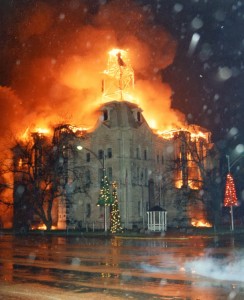 |
| Hill County Courthouse, Jan. 1, 1992 |
When I started, I worked in an office carved out of the district courtroom on the second floor just across from the windows above the door in the non-fire picture. After the restoration, the district courtroom was put back into its original condition, and the county attorney’s office was moved to the third floor on the south east corner (the left side of the visible face in the picture), just under the mini-tower on the corner.
Counties in Texas are governed by the commissioner’s court which is presided over by the county judge. This is an administrative, executive position, NOT a judicial position. Originally, it was both, but in most counties, they have created County Courts at Law which have taken over all the judicial tasks.
When I worked at the courthouse, back in the ’90s (we moved to the Panhandle and Donley County in 1999), the county judge still handled the judicial responsibilities because the Texas Constitution had a Hill County-specific constitutional amendment placing the county court under the supervision of the district court. Now, there is a county court at law in Hill County and an old friendly acquaintance of mine is the judge. (I’m tickled pink about it. He’s a good guy. I’m sure he’s an excellent judge.) However, there are still some rural counties where the county judge handles the judicial responsibilities.
 |
| Donley County Courthouse, Clarendon, built 1890 |
The commissioner’s court is the legislative body of the county and they are in charge of the county’s budget. Even though all those other people–from the sheriff to the tax assessor-collector–are elected, the commissioner’s court is in charge of how much money they get. This can make things awkward when the officials get crosswise with each other. I remember one instance when the sheriff in Tarrant County (Fort Worth) was doing some things the commissioners didn’t like–buying helicopters and other “crazy” things–and they tried to bring him to heel by cutting off his funds. Didn’t work too well.
There are four commissioners in each county. Besides being in charge of setting the county’s budget and passing local ordinances (very few) and approving residential plats (very few bother to ask for approval), the commissioners are in charge of the construction and maintenance of the roads and bridges in their precinct. (They even put up pictures of it on the county website…) This is why county commissioners are often called Road Commissioners. The names are pretty much interchangeable, especially in the rural counties. Tommy Joe Davis, who was tax assessor-collector when I lived in Hill County, used to joke that the best way to get new computers for the courthouse offices was to paint them yellow and stick a grading blade on the front. It can sometimes be hard to get road commissioners to approve funds for anything but road repair equipment.
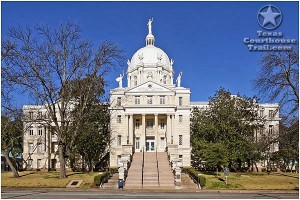 |
| McLennan County Courthouse, in Waco, built 1901 |
Yes, it can be confusing to have the CEO of the county called the county judge, and the judges of the county courts at law (which are primarily criminal courts handling misdemeanors, but can also handle some minor civil matters) all called county judges. But only one is The County Judge. And he’s the only one who isn’t an actual judge in a court of law.
(I lived in McLennan County while I was attending Baylor University, which is in Waco, and we lived there the first year the fella and I were married, while he was finishing up his Master’s.)
By the state constitution, each of the 254 counties has four justices of the peace and four constables. Texas JPs have constitutionally been the ones to pronounce cause of death, and at least one of them is famous for having declared the cause of death to be “lead poisoning” because the dead man got shot full of lead bullets. These days, they do not have to be lawyers, but they do have to attend quite a bit of training. In most places they no longer have to go out to deaths, unless it’s a very rural county, but they still have to sign the paperwork. They also preside over courts handling traffic tickets in the rural areas, and like all the other judges, they can marry people. (The district court judge in Hill County–a good friend and second cousin once removed of the fella’s–performed the wedding of our older son.) (District judges can also waive the three-day waiting period of the marriage license, if you need that in your story.)
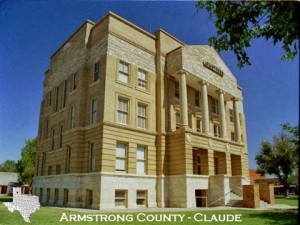 |
| Armstrong County Courthouse, built 1912 |
At the moment, Galveston County has nine (9) justices of the peace, and I think, 9 constables to go with them. (The constitution allows the county to create more, but each county has to have at least four.) The current commissioner’s court is trying to reduce that back to the constitutional four to save money, and of course, the JPs are fighting them because they don’t want to lose their jobs. It’s a big political mess, and quite the fight.
(I never lived in Armstrong County, but I drove through Claude once a week, right by the courthouse, on my way into Amarillo, when we lived up that way. It has one of the more modern-looking courthouses… The city-county library is in the basement…)
Constables provide security for the JP courts, and spend most of the rest of their time on the job as process servers. This saves the sheriff money and time having his/her personnel doing the job. We have to have constables anyway, so they may as well take some of the work from the sheriff’s office. But they don’t always. Only if the sheriff wants to give the work away. And remember, all these people are elected. Every single one of them.
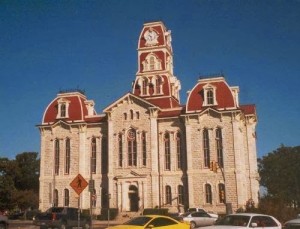 |
| Parker County Courthouse, Weatherford, 1894 |
I’ve mentioned the tax assessor-collector a number of times. This is another elected office, and one of the few constitutionally mandated county-wide elected offices. (District judges and district clerks are elected, but sometimes they’re for more than one county, and sometimes, there’s more than one in a county.) The tax assessor-collector collects taxes for the county but can also collect them for other governmental entities. School districts, community college districts, MUDs, even smaller cities can and often do contract with the tax assessor-collector. They are the ones who handle car registrations (license plates) and car titles. The tax assessor-collector office even issues the beer and wine sales permits.
(I never lived in Parker County, but doesn’t the courthouse look like the one in Hillsboro? Except the roofs are colored! And it’s only two stories… Or looks like it.)
Every county in Texas has a sheriff. But the sheriff in an urban county has somewhat different responsibilities than one in a rural county–or, rather, he is charged with the same responsibilities: maintaining and operating the county jail and policing the unincorporated areas of the county. But those duties play out differently in rural and urban areas.
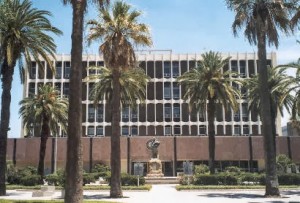 |
| Galveston County Courthouse, Galveston, 1966 |
Most urban counties, especially the ones with the “big six” cities, don’t have a lot of unincorporated land. The city–or cities, because most of them have suburbs in the county with the city–fill it all up. Tarrant County has Fort Worth, but it also has Arlington, Hurst, Euless, Bedford, North Richland Hills, Saginaw–and probably more, but I’m not sure if they’re all in Tarrant County. Same with Dallas. Dallas County also has Irving, Grand Prairie, Richardson, Plano, Mesquite, etc., etc. But not much territory that’s not inside the limits of all those cities. Harris County, where Houston is, has more unincorporated land than most large-city counties, because it’s a large county. But still, it doesn’t have nearly as much as Brewster County. Or even Briscoe County. Because those are rural counties.
(The 1899 Galveston County Courthouse was across the street from this one, but it was torn down in 1966. It’s entirely possible that the old one was damaged badly in Hurricane Carla in 1961, but I can’t find any confirmation of that. This one was finished only five years after Carla, which is really soon, given how slowly things move in government, especially after hurricanes. There are no courts of law in this courthouse. The federal court is in the post office/federal building down on 25th Street, and the state and county courts are in the new justice complex right at the entrance to the island on Broadway.)
 |
| Old Galveston County Courthouse, 1899, demolished 1966 |
What those large counties do have is lots of criminals. They need big jails. So urban sheriffs spend most of their time managing the county jail. The county jail is required to hold the people the cities arrest until they make bail or go to court. Most cities have fairly small jails, because they’re expensive and because they only have to hold arrestees long enough to cart them over to the county jail. This is why the Tarrant County commissioners got so peeved with their sheriff, because he was buying helicopters to police the unincorporated parts of the county, and Tarrant doesn’t have much in the way of unincorporated parts. The commissioners thought he should spend more money on the jail. Remember, the sheriff is an elected position. He has to run for office every four years. Used to be every two, but now it’s four. The sheriff runs when the governor runs, which is in the even-numbered year between presidential elections.
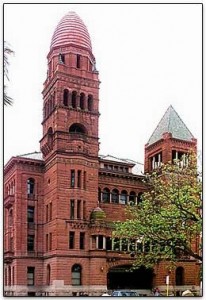 |
| Bexar County Courthouse, San Antonio, 1896 |
Even in rural counties, the way the sheriff does things can be different. In Hill County, which was and is a rural county, there were four fair-sized cities: Hillsboro, Whitney, Itasca and Hubbard. (There are also the micro-cities of Aquilla, Brandon, Blum and maybe one other, but those cities are really small and don’t have their own police.) Hillsboro had a population of just over 5,000 when we lived there, now it’s about 8,500. The other cities are smaller. But they all had their own police departments. Hillsboro had about 10 or 15 officers, and even had a two-man detective bureau. Whitney had 3 to 5 officers, Itasca and Hubbard each had two. The sheriff backed them all up, and policed everything else. The sheriff had more deputies than any of the police departments. When that boy was running from the police in his cotton stripper, he was running from the sheriff’s deputies.
(I included the Bexar County Courthouse because it has such a distinctive look. Plus my dad lived in San Antonio. But really, what other government building has such a phallic looking red tower???)
When we moved to Donley County, the largest town in the county, Clarendon, had a population of just under 2,000. Howardwick, the town out by Greenbelt Lake, had a population of 300 or so, and Hedley is about the same size. And the sheriff policed it all. Clarendon didn’t want to have to hire police officers. They helped pay for the sheriff’s office, but the sheriff handled everything. And the jail was on a corner of the courthouse square. Thing is, because the county is so rural–all those cows don’t commit much crime–and it’s not on the Mexican border, so the sheriff and his not-very-many deputies could handle pretty much everything. There were some highway patrolmen who lived in town, too. The road from Dallas to the skiing mountains in Colorado runs through Donley County, so people had/have a bad tendency to speed. Clarendon only had one stop light. Did they really have to run it?
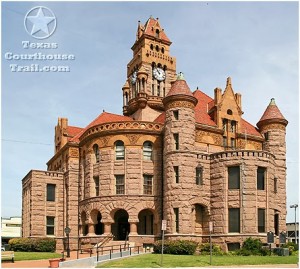 |
| Wise County Courthouse, Decatur, 1896 |
One more thing. I had a friend who wanted to write a book where the hero’s and the heroine’s relatives were running for the same local office–county commissioner or something–so that the politics would amp up both the humor and the conflict in the story. And her editor (from New York City) thought they should be running for the Senate (The U.S. Senate, not the state senate), because local politics just wouldn’t be important enough to create much conflict. And that’s just wrong.
(Never lived in Wise County either, but drove through Decatur a lot of times. It’s on the same highway Clarendon is, just a lot closer to Fort Worth. And I like their courthouse.)
First off, a person running for senator in Texas would be running a statewide race. And Texas is a really wide state. Remember, it’s almost 1000 miles from top to bottom, side to side. They would be spending most of their time running from one side of the state to the other, from one of the Big Six cities to the other. They wouldn’t have time to get personal. It’s not a personal race. And that’s the thing about local politics. It’s personal.
People tend to get a whole lot more “het up” about local races than they do about political races where they don’t have to deal with the elected official every day. When the winner goes way off somewhere, like Austin, or even Washington, D.C. Maybe those larger races carry more clout in the larger world. But they’re not important. They’re not personal. It’s not Butch from down the street trying to cut out John from church in that respected role. Or even Aunt Myrtie. Local elections can create a whole lot more conflict than any statewide or even national election any day. Especially in a small town in a rural county.
What else might you want to know?
 |
| Montague County Courthouse, Montague, 1912 |
Oh. A couple of “pronounciation” things: Montague County. It’s not pronounced “MON-ta-Gue” (rhyming with glue or Gru from Despicable Me), it’s pronounced “Mon-Tayg” (with a hard G at the end and both syllables getting the same emphasis). And Borger (historic oil town in the Panhandle, with a still operating oil refinery) is pronounced with a hard G. It’s not “Bor-jer.”
This is NOT a comprehensive, formal survey of local Texas government. It’s just a bunch of stuff writers might want/need to know. A jumping-off point for things to research. Hope it helps somebody…
]]>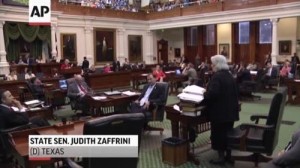
Most folks who observe Texas politics and government are pretty much in agreement with the late, great Molly Ivins. Texas government is a spectator sport.
That being said, The Main Thing that a writer must remember is that at the local level most people write about–Everybody’s elected. All the bosses are, anyway. And there is no such thing as a concentration of power. Or even a city school district. The schools–and sometimes the utilities, and other stuff I’m not remembering right now–are run by their own independently elected board of trustees. As are the junior colleges.
The four-year state colleges have appointed boards, and there are a few other state-level committees and boards that are appointed. But the State Board of Eduction is elected. The Railroad Commission–which does regulate railroads and transportation, but more importantly, is in charge of mineral licensing and how much oil, gas, etc. can be taken out of the ground–is elected. However, who’s going to write about the Railroad Commission? Well, maybe somebody will come up with a great way to bring them into a murder mystery that starts with corruption in the commission and links to Big Oil and wildcatters and… Go ahead and use that one. My brain hurts already.
The main thing to remember is that Everybody’s Elected. I mean, EVERYBODY. Which makes for a lot of peculiarities. I’ve lived here all my adult life, so I’m used to it. Every school district is an ISD (Independent School District), so there’s GISD for Galveston Independent School District, and FWISD for Fort Worth Inde– etc., etc. And MUD stands for Municipal Utility District.
And nobody’s in charge of anybody else. I used to work for the County Attorney in Hill County where I-35 splits to go to Dallas AND Fort Worth. He’s an elected official like all the others, and sometimes people would get mad at him for not prosecuting a misdemeanor case the way they thought he should, or for prosecuting somebody they didn’t think should be, or for talking to them wrong, or not talking to them, or whatever, and they would want to talk to his boss. And I would get to gently explain that if the angry person was a voter in Hill County, then they were his boss, along with all the other voters in Hill County. But otherwise, he didn’t have one. Because he was an elected official. As you can imagine, if all those elected officials get along fine, things work. If they don’t…
How did we get this way? Well. It all goes back to the Civil War.
Texas was a part of the Confederacy. Secession was not unanimous. Sam Houston was one of the most prominent of those opposed to leaving the United States but his attitude didn’t prevail, and he was deposed as governor and dropped from polite society. Very little of the Civil War took place in Texas. Mostly Texas participated by sending Hood’s Texas Brigade and a lot of other soldiers. Galveston was briefly occupied by the Union Army and the Battle of Palmito Ranch down near Mexico was fought after Lee surrendered, and that was pretty much it.
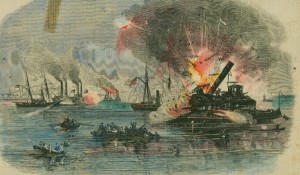 |
| Battle of Galveston Bay (first or second-I’m not sure) |
However, during the Civil War, the Comanche pushed back the frontier and a number of forts were abandoned, among them Fort Fisher along the Brazos River near Whitney where I used to live. It was pushed back clear to Fort Parker, a Texas Ranger fort also along the Brazos in Waco, where the Texas Ranger Hall of Fame is today. Check the map. This is the middle of the state. The Rangers protected the settlers from the Comanche and the outlaws.
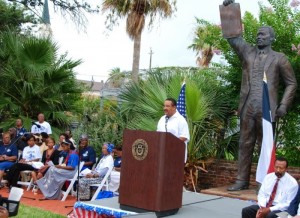 |
| Juneteenth celebration 2012 at Ashton Villa |
Then the war was over. It took a while for word of it to reach Texas. The Emancipation Proclamation was read to slaves in Texas for the first time at Ashton Villa on Galveston Island on June 19, 1865. Juneteenth is still celebrated in Galveston by reading the proclamation at Ashton Villa, then everybody walks over to the park for a party. The local folks want to make it a national holiday… at least on the level of Flag Day.
Reconstruction began with Lincoln’s gentle version at first, but the Radical Republicans, as they called themselves, had trouble with wholesale forgiveness and they truly wanted to make the freed slaves equals. A lot of them did, anyway. And when they took over Congress in 1866, they sent in troops to occupy the rebel states and made enemies. It was kind of a cold war.
In Texas, which suffered somewhat less than the other states because there was less destruction of property than in, say, Atlanta, Edmund J. Davis was elected governor under a new, Reconstruction-created constitution. He was an ally of Sam Houston’s in the secession argument and left the state after they lost the argument, joining the Union Army and creating a regiment of Unionist Texans. He truly believed in the cause of emancipation. But he may not have been the most politic of men. He made a lot of enemies.
He disbanded the Texas Rangers, which made him a lot of enemies right there, and created the Texas State Police. A lot of the State Police were former Rangers and became Rangers again after the State Police were disbanded and the Rangers reconstituted. The chief of the state police embezzled a ton of money (especially for that era) and a lot of the crimes they enforced were white-on-black crimes, which did not endear them to the unregenerate Confederates.
 |
| Old Stone Capitol |
Texas was readmitted to the Union in 1870, the last state except for Georgia to be officially admitted, and Georgia was only three or four months behind. It operated under that Reconstruction constitution, which went into force in 1869, until the election of 1873 when Ed Davis lost in an election that abounded with irregularities. Because of all those irregularities, he barricaded himself in the capitol (not the current state capitol, but the one they had before, called the Old Stone Capitol. I think it burned down, but anyway, it was replaced.) and folks broke out ladders to climb in the windows.
Davis appealed to President U.S. Grant for troops to enforce his governorship and when Grant refused, Davis grudgingly evacuated the building. But he locked the governor’s office and took the key with him. They had to break the door down with an ax to get in. (I just love these peculiarities and perversities of history.  Which is why I keep sticking them in when I’m trying to get through this quickly.) (Oh, and the current capitol building of Texas? It’s pink. Because it’s built out of Texas granite and all Texas granite is pink. (The rock jetties on Galveston are Texas granite. They’re pink too.) When it’s weathered, it looks a little more tan, but really, it’s pink.)
Which is why I keep sticking them in when I’m trying to get through this quickly.) (Oh, and the current capitol building of Texas? It’s pink. Because it’s built out of Texas granite and all Texas granite is pink. (The rock jetties on Galveston are Texas granite. They’re pink too.) When it’s weathered, it looks a little more tan, but really, it’s pink.)
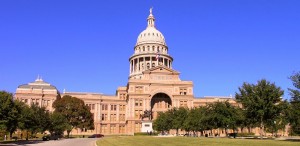 |
| Texas State Capitol, today |
Okay, so Davis is out. The federal troops are out. Texans don’t like the constitution they feel was forced on them during Reconstruction, so they convene a new constitutional convention to write another one. They didn’t like Davis or the way he governed. They didn’t like the government telling them what to do. The way they figured it, the best way to keep control of those interfering government folks was to make as many of them as they could get elected regularly, keep the legislature from meeting very often, and take as much of the power away from the governor as they could. So that’s what they did.
The Texas State Constitution is the third longest state constitution, shorter only than that of Alabama (which has been amended 800 times) and California (which has to deal with that citizen initiative thing). It is a prescriptive constitution, meaning that there is no “Necessary and Proper” clause as in the U.S. Constitution. Only the things prescribed in the constitution are allowed. It has been amended over 475 times (that was the count in 2010, and I know we’ve passed up to a dozen amendments in pretty much every election since) (Including just county elections–the state tends to tack them on), sometimes a specific amendment for a specific county.
The governor is one of the weakest in the country, many of his powers divided with the lieutenant governor, because the folks who wrote the current constitution hated Ed Davis and didn’t want any governor forever after to have the kinds of powers that Davis had. So, the lieutenant governor runs independently of the governor and appoints nearly as many positions on the various executive boards as the governor does. These boards do a lot of the running of the state. The lieutenant governor is the presiding officer of the Texas Senate, has that as a power base as well. He or she is not always of the same party as the governor. Remember, they do not run as a “set.”
 |
| Rick Perry, left, with David Dewhurst |
The current LG, David Dewhurst, is a bit of a nonentity and not considered terribly effective, while Governor Rick Perry has been in office longer than any other governor, ever. His longevity has given him more power than governors have usually had. But when George W. Bush was governor, he had a powerful Democrat as his lieutenant governor and believe me, Bob Bullock exercised that power. Personalities still do count.
Besides requiring the election of everybody from constables, justices of the peace, judges at every level (including the Supreme Court and Court of Criminal Appeals–which are each the supreme court of the state, one for civil cases only and one for criminal cases only), county tax assessor-collectors, to Texas Education Board members and Railroad Commissioners, those government-averse Texans of 1873-ish decided that the less the legislature met, the less it could mess things up. So the Texas Legislature meets only once every two years, beginning in January of the year following the election, for 140 days, usually ending in late May or early June, depending on when, exactly, they started. Legislators and state senators are elected in November, every two years, and in January, they convene in Austin. The governor can call special sessions for specific purposes, and those special sessions last for only 30 days. In 2013, Governor Perry called two special sessions in a row immediately after the regular session ended and totally pissed off the legislators. They wanted to go home and get back to business. Because the Texas Legislature is so very part time, it tends to be popular with lawyers, insurance agents, doctors, homemakers, and others among the self-employed. But even they eventually need to go back to work.
This is definitely just a skim-over of how government (at the state level) works and how it got this way. I used to teach this stuff at the college level and it took a good quarter of the semester to cover just the historical stuff. It’s probably not something you will need to know except for deep background, but it’s a good stuff to be aware of. Texas doesn’t work like other places. I don’t know any other state in which the legislature meets only once every other year. Or that has quite so many elected officials. Or where neither the city nor the county has anything to do with the schools.
Just remember, if you’re a school kid researching Texas government–leave now and go find a more official site. Or if you’re a writer working on a murder mystery about corruption in big oil, leave now and go look up the Texas Railroad Commission. Because this isn’t official, nor is it complete.
This is already a long post, so I’m going to do another blog-post on how things are organized at the local level. I’ve lived in a county with a population of 30,000, in a county with a population of 3,000, and now in a county with a population of almost 300,000 (2010 census), right next to the most populous county in the state. But county organization is mostly the same, unless there is a constitutional amendment for that county. (Hill County had one, reorganizing its courts.)
Now, go forth and research.
]]>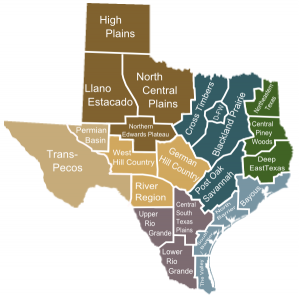
So. In this blogpost, I am going to write about the South Texas Plains. You will see that the region is divided into the Central South Texas Plains, the Upper Rio Grande and the Lower Rio Grande. I will be honest with you. I’ve never lived in this part of Texas. My dad grew up in San Antonio, and the fella had an uncle who lived in Laredo a decade or so, but other than that, I’ve mostly just driven across it a couple of times, and that was a while ago. So I’m going to have to do a fair bit of research on this. Which is kind of the point. The information is there, if one will go out and look for it.
Daddy was an army brat–his dad joined up for WWI and retired before I was born. (I am a Texan. My father was Daddy till the day he died, and my mother’s father was too. The fella is Grandaddy, as is his father. Our children get away with calling him Dad.) His family lived in San Antonio in what our Latino friends called “the bad part of town” while I was growing up. The house was just down the street from the old Mission Ballpark. It
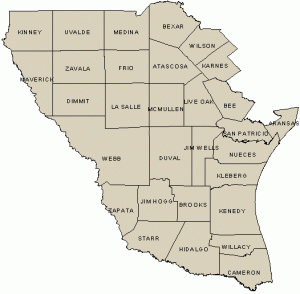 |
| South Texas plains does not include coastal counties |
was across the street from a city park and playground through which the San Antonio River ran. That part of the river isn’t dammed up and restrained like the part that runs through downtown and the Riverwalk. When I was little, the Riverwalk was pretty barren. No restaurants with outdoor dining or water taxi tours. That started up mostly when Hemisfair came to San Antonio, when I was just starting high school. (Yes, I am dating myself here.) The river in the park sometimes flooded, and sometimes it was just puddles and we would go play in the river bed.
When my Aunt Mary was getting married in the big old house, they sent all the uncles (and Daddy) out with all the kids (mostly just me and my siblings) to tour all the missions in San Antonio. There are a lot of missions in San Antonio. We did the San Jose Mission (San Jose y San Miguel de Aguayo), Concepcion Mission (Nuestra Senora de la Purisma Concepcion de Acuna), San Juan Capistrano (yes, there is one in Texas, too), San Francisco de la Espada, and we may have gone to the Alamo as well (AKA Mission San Antonio de Valero). Mostly I remember chasing a lot of peacocks and noticing that all the giant blue agave plants on the mission grounds–the plants that
tequila is made from–had initials carved in their thick leaves. I tried carving my own, using one of the needles pulled off the end of the leaf. These plants were huge–five feet or more tall and as big around. Much bigger than the ones they harvest for tequila…
San Antonio is the second biggest city in Texas and one of the fastest growing in the country. It sprawls in all directions, like most Texas cities. It has some very wealthy and beautiful sections and some dirt poor sections like the one that grew up around my grandparents’ house. San Antonio streets have their issues. Because the San Antonio climate tends to be dry, there are a lot of low water crossings–places that fill up with water when it rains. But since it doesn’t rain often, they don’t get around to building bridges. Which means that when San Antonio has one of its frequent flash floods–because when it rains in the area, it tends to rain really hard and then quit–they tend to have a lot of people get swept away in the flash floods because the drivers drive around the railroad-crossing-type barricades. It’s getting better than it used to be, but they still lose a few teenagers every year.
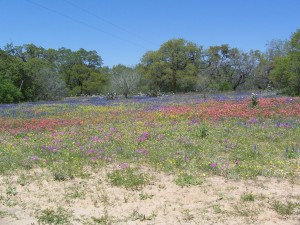 |
| Southeast of San Antonio, toward Floresville |
You can drive southwest-ish from San Antonio and reach Laredo on the border in a couple of hours. You can drive southeast and get to Corpus Christi in only a few more. San Antonio is in Bexar County and Laredo is in Webb. Corpus is in Nueces County, but it’s on the coast, so it’s rightfully part of the coastal geographic region. Just as East Texas is more than the Piney Woods, South Texas is more than just the Plains. East Texas is everything east of Interstate 45. South Texas is pretty much everything south of San Antonio. You will note in those diagrams up above that in both of them, South Texas angles southerly down toward San Patricio and Aransas (pronounced a-RAN-zuss, if you’ll recall) Counties. So you can’t draw a line along Interstate 10, which connects San Antonio and Houston, and say everything south of that is South Texas. Because it angles. The Houston TV stations like to talk about Houston being in South Texas, but it isn’t. It’s sort of in South East Texas. Sort of. But San Antonio is definitely considered the gateway to South Texas.
San Antonio is the “big city” in South Texas. Laredo is the second largest city at 244,000+ population if we’re discounting the row of coastal counties. If we kick all of those out, we’re left with McAllen (over 100,000), Edinburg (81,000) and smaller towns. (Of course, kicking the coastal counties out only deprives us of the large cities of Corpus Christi and Brownsville…) There are plenty of small towns in South Texas, and plenty of ranches. Just remember, this is south Texas. Close to the Mexican border.
As you go north along the Rio Grande, you get into more and more hills and bluffs and gulleys, but before it gets very hilly, you’re in the Hill Country, which does bump up against the border. Mostly, South Texas is plains. It’s more of the flat countryside. In the spring, you will see wildflowers. Otherwise, it’s pretty much just mesquite trees, prickly pears and more or less grass, depending on how dry the year has been. A lot of the time, the grass is the same color as the dirt, so you can’t necessarily tell how dry it’s been. I remember being very bored by the landscape, driving both to Laredo and to Corpus. And I don’t remember the mesquite trees being as big as the ones in this picture. I remember them being about as tall as the prickly pears. This scene is pretty typical however all across the state. I’ve seen places like it in the Panhandle and all the way south to the Rio Grande.
Mesquites are nasty trees. I mean, if they’re all you have for shade, then okay. But they’re bad in pastures because they suck up all the available moisture and make the grass more scarce. The cows will eat the mesquite beans, if they have nothing else, and then poop out the seeds and help spread the trees. I think this may be why mesquite has become so popular as wood for barbecue. Because the ranchers want them out of their fields, and if somebody will buy the wood, even better. But it does make good barbecue… (Mesquite trees also have thorns. Mesquites are a large part of the reason for chaps.)
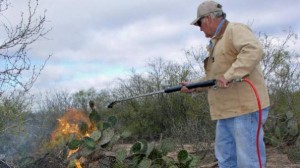 |
| “Chamuscando” |
Cows will eat a lot of things if they’re hungry enough. My mother tells stories about helping to burn the spines off prickly pear pads when she was a little girl so the cows wouldn’t get them in their mouths. She and her sisters would put the prickly pears on sticks and hold them over the fire–just like they did back in the 1700s when the Spanish and the Mexicans held Texas. Nowdays, they use a sort of flamethrower. The old Spanish word for burning off the spines is chamuscando. Which apparently means “burning spines off prickly pears.”
If you don’t burn the spines off the prickly pears, the cows will eat them anyway and get the spines all in their mouths–and prickly pears? They have big spines arranged sporadically like polka-dots across both sides, and surrounding those big spines? There are hundreds of tiny, hairlike spines that are murder to get out. (Yes, I have been stabbed by prickly pears. Both kinds of spines.) And they hurt like the devil when you get punctured with them. The poor cows don’t get much good out of eating the pears–they’re mostly fiber and moisture, but they fill their bellies. And if the spines don’t get burned off, the cows will be walking around with their mouths all swollen up and sore from the spines stuck in there. Poor cows.
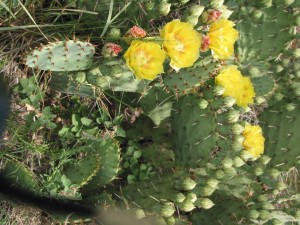 |
| Panhandle Prickly Pear |
The South Texas Plains are dry. They’re flat. But they’re not desert. Quite. There’s lots of brush and mesquite trees and grass. The plains support lots and lots of deer, hogs, and cattle. Turkeys and quail, javelina–which are different from feral hogs. The mountain desert in New Mexico and Arizona will support quite a bit of wildlife too, but not as much as South Texas. It’s a brushy dry. And there are still a lot of wildflowers. Even prickly pears bloom. You ever see one?
I took this picture. It’s a Panhandle prickly pear, but they all look the same whatever part of Texas they’re in. Note the spines across the pads? Every one of those big ones is surrounded by a host of those tiny ones. They’re used in Mexican cooking. The pads as well as the fruit. Nopalitos are prickly pear, if you ever happen to see them in a grocery store or restaurant menu. And yes, they do take the spines off before cooking them. Or even bringing them into the store. (In fact, I think they’re peeled…)
This is the part of the state that used to have uranium mines–mostly surface mines. It’s the part of the state that’s getting torn up by fracking. The big trucks are tearing up the roads, along with the water-that-catches-fire stuff you get elsewhere. The locals are not happy, but the state powers-that-be don’t listen too well. (sigh.)
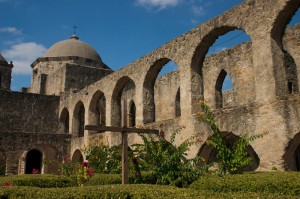 |
| Mission San Jose in San Antonio |
I feel like I should be telling you more, but I’m not sure what to say. The terrain really does look pretty much the same all across the region. There are hills and gulleys, so individual places are different, but overall… it’s brushy plains. I’ve given you all the anecdotes I can think of. Um–no, I’ll save that one for when I’m talking about Texas politics.
Anything else I come up with would be from things I’ve researched. And that’s your job. Look at a map. Look at the images that Google pulls up. Read the Wikipedia entry on South Texas. At the very least. I would recommend just putting South Texas as your search term for images, because when I put in South Texas Plains, I got a lot of Panhandle images. Not a whole lot different, to be honest, because the plains in South Texas are just the southernmost point of the Great Plains that start up in Canada. Think of it as plains rather than desert, and you’ll probably get closer to right.
Not trying to be comprehensive or definitive. Just trying to get folks to think about what Texas really is, and maybe point a few writers in the right direction for research. Hope I’m helpful.
]]> Hey, look what I found! A map with subregions on it. You know how I talked about “Deep East Texas” or about the blackland prairie? Well, this map shows those subregions. Pretty cool, huh. This will really be helpful when I get to talk about the Panhandle Plains region. Because those sectors are pretty different–and yet similar. And that section in blue called Post Oak Savannah? It has stretches of meadow crossed with woods. It’s just that more of them are Post Oaks. And Live Oaks. Lots of live oaks. And native pecans.
Hey, look what I found! A map with subregions on it. You know how I talked about “Deep East Texas” or about the blackland prairie? Well, this map shows those subregions. Pretty cool, huh. This will really be helpful when I get to talk about the Panhandle Plains region. Because those sectors are pretty different–and yet similar. And that section in blue called Post Oak Savannah? It has stretches of meadow crossed with woods. It’s just that more of them are Post Oaks. And Live Oaks. Lots of live oaks. And native pecans.
This is kind of a bonus blogpost. I’m sticking in a lot of smaller things that probably aren’t big enough for their own blogpost, but that I think really need to be mentioned. Some of them are things I forgot to mention in other posts. Others are little things that I found in books. Again. And yet others are things I’ve been tripping over regularly in other posts–and probably will again.
Surfing in Texas
First, I want to talk about something I meant to mention in the post about the Texas coast, but just ran out of room. That one is already a long post as it is. So, surfing.
Yeah, Texas has a long coast, but you never really hear about surfers catching waves here. That’s because, well, frankly–surfing in Texas sucks.
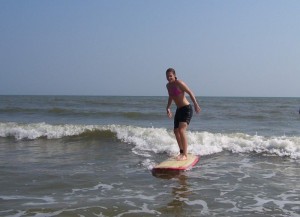 |
| Surf lessons at Surfside beach |
Sorry, all you Texas promoters, but it does. Because the surf along the Texas coast is very gentle. It’s mild. Some days, there isn’t any surf at all. The water is like glass almost all the way in. You usually get a few waves a couple of feet from shore, and most days, there’s a little more surf out to about 100 yards or so. The baby surf in the picture here is pretty typical. The waves just aren’t that big.
This is because the slope of the Gulf of Mexico as it’s coming up to Texas is very shallow. You don’t reach deep water until you’re 50 to 70 miles offshore. Surfing-worthy waves are created by deep water suddenly reaching a shallow shore. On the Texas coast, there’s nothing sudden about it. It’s shallow a long, long way out. The Gulf shore is fairly shallow and gradual all the way around to Florida, but off Texas, it’s the shallowest and most gradual.
What this means is that the Texas coast is fabulous for families, for swimming and for learning to surf. The surf will not beat you to death. Frankly, while I’ve never actually been to the beach in California, just watching movies of the surf there makes me think I would hate it. My sister–who has been swimming in the Pacific, said it knocked her down, rolled her around and beat her up. We both love swimming on Texas beaches. You can get out beyond the surf and just rock on the rolling glassy waves. It’s peaceful, the way the water picks you up and sets you gently down again.
Wake surfing in the wake of big cargo ships was invented in Bolivar Pass (north end of Galveston Island, on the way up the Houston Ship Channel), because the regular surf is so sucky. So–if you’re just learning to surf, you might want to try South Padre Island (the surf is a little better down there, I think). If you have small children or enjoy swimming without getting battered, you might like Texas beaches. If you are a big-time surfer, then no. You’ll probably hate it here. The rest of you? Come on. The beach is just fine.
Indians in Texas
This next little bit came from a book I read. It was talking about how the B&B in this little Texas ranch town was furnished with blankets woven by Indians native to the area. It was a contemporary novel, which made it sound like the Indians were still hanging around. And a few pages later, the book specifically mentioned “Comanche-woven blankets.” Which made me choke on my Coke Zero.
 Why, you ask? Because Comanches didn’t weave blankets. They lived in tipis and everything they owned was portable. They were quintessential nomadic plains Indians. They had no crafts that were not based on the buffalo. They didn’t even wear feathered headdresses until after they were confined to reservations in Oklahoma.
Why, you ask? Because Comanches didn’t weave blankets. They lived in tipis and everything they owned was portable. They were quintessential nomadic plains Indians. They had no crafts that were not based on the buffalo. They didn’t even wear feathered headdresses until after they were confined to reservations in Oklahoma.
Which kind of brings us back to the idea of “local Indians.” There are from my admittedly brief research, three Indian reservations in Texas. The Alabama-Coushatta reservation is in Liberty County, near Livingston in Deep East Texas. There’s a Kickapoo reservation right on the Rio Grande south of Eagle Pass in Maverick County of about 120 acres, and there’s a Tigua Pueblo reservation in El Paso. None of the three is anywhere near the central Texas area where I finally decided this particular ranch town was located. Most of the rest of the natives in Texas were squashed into Oklahoma. The Comanche went there–after most of them were killed in the Red River Wars. The Tonkawa were sent there, even though they sided with the Texans and helped fight against the Comanche and other Plains Indians in those wars. And in Oklahoma, those Plains Indians ganged up on the Tonkawa and pretty much wiped them out.
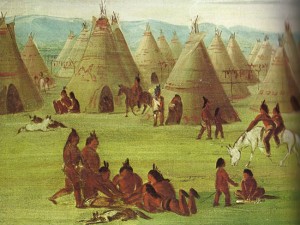 |
| George Catlin painting, approx. 1834 |
Admittedly, I already knew there weren’t many reservations in Texas. The Kickapoo Nation wasn’t recognized by the state until 1977. I actually vaguely remember that. And how small their reservation is. And I already knew that Comanche didn’t weave blankets. Not only were they nomads, but, as my friend with a Comanche grandmother always said–they were too mean. I looked up what I was pretty certain I already knew, to be sure–and I easily found the confirmation. Cherokee weave blankets. Navajo weave blankets. There may be a few other tribes. But unless there are contemporary Comanche artists who have decided to take up weaving as their art, the Comanche do not traditionally weave blankets. Or make pots, or weave baskets. Nor do most of the other nomadic tribes of the plains.
“Pronounciation”
This brings us indirectly around to the way Texans pronounce things. Because a number of towns and places in Texas have Indian names.
I tend to tell people plainly, right up front that I don’t speak English. I speak Texan. And when it comes to some of our place names–the ones from Spanish and other languages, such as the Indians’– We don’t speak our own language the way everybody else does. What makes you think we’ll do any better with someone else’s? The Texas accent is distinctive and we are unapologetic about it.
San Antonio is in Bexar County. Not pronounced Beh-HAR, as it would be in Spanish, but like the aspirin. BAY-er County. The Pedernales River is the Perd’n-Alice. The town of Refugio, Texas was pronounced Re-FYUR-io, last time I heard anybody say it. I’ve known a man whose first name is Refugio–he goes by Fu.
And I’m not sure where they got the pronunciation of Mexia, Texas. There’s a state school for the mentally handicapped in Mexia, which is in the Crosstimbers some distance east of Waco. Anyway, in Spanish, it would be Meh-HEE-ah, and you’d think that Texans would mispronounce it as MEX-ee-a. But we don’t. It’s Ma-HAY-ah.
My neighbors are the AlvaRAHdos. The town near Fort Worth is Al-va-RAY-da. Both spelled Alvarado, but different. I went to high school with the Na-VAHR-ro boys. But the county Corsicana is in is Na-VAIR-ra. Both spelled Navarro. The country is IT-a-ly. The town in Texas is IT-ly. That middle A is completely gone. And those folks in Itly are tough.
Lamesa is La-MEE-sa. But Quanah is KWA-nah. And while pronouncing the first syllable of Waxahachie like the substance candles are made of is tolerated, it’s really WAHX-a-Hatch-ie. It took me a while to learn how Quitaque was pronounced, since I wasn’t sure whether it was a Spanish name or Comanche. I think it’s Indian of some kind, probably Comanche, and it’s pronounced Kitty-Kway. It’s up in the Plains area, south of Clarendon. They had the only drive-in theater for a while, until the one in Clarendon was re-opened. Waco comes from the Huaco Indians who used to live there at the confluence of the Bosque and Brazos Rivers. But we changed the pronunciation of HUAH-co to WAY-co. Possibly to cut down on the incidence of “wacky” comments. There’s a creek named Tehuacana, that’s pronounced Tawakoni, like the tribe in the map above. So maybe the Spaniards changed the spelling. And Tonkawa Falls is somewhere between Waco and Temple.
Of course, for writers, it doesn’t really matter how these place names are pronounced. They’re still spelled the same. But it’s something that you can use. You can have the out-of-towner fixing to go over to MEX-ee-a, and nobody knows what she’s talking about. Or just trying to figure out how to say Waxahachie. Or Nacogdoches. (Nack-a-DOE-chess) (Not nearly as tough as Natchitoches, LA– which is NACK-a-tish)
I lived for 20 years on a street that dead-ended into Towash Road which ran alongside Towash Creek, and never did quite figure out how to say it. I think mostly I used “TOE-wash,” but I have been told it’s everything from that to “Tow” rhyming with cow and “ash” like the fire residue, to “to-WASH” because people used to go to the creek to wash things. I kind of wonder if anybody knows…
Mines, bats, and caves
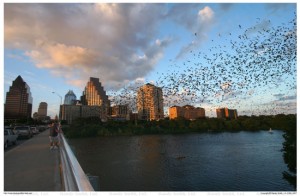 |
| Austin, Congress Street Bridge |
Now we come to another item gleaned from a book. I don’t think the author necessarily got this wrong, per se. But I found it rather troubling. She had bats swarming out of an abandoned mine on this central Texas ranch.
Now, bats do swarm in Texas. Austin is locally famous for the large colony of Mexican free-tailed bats that live under the Congress Avenue bridge in downtown Austin and all fly out to feed at dusk. People gather on the bridge at dusk just to watch the bats. Austin’s minor league hockey team is the Ice Bats.
Bats are not good when they get inside your attic. The Donley County courthouse smelled funny until they got the bats out–but the Girl Scouts built bat houses and hung them up in the trees on the courthouse square so the bats would have a place to live. (Don’t know if the bats ever used them–but they banished them from the library attic too, so maybe they needed other places to live.) We actually like bats, because of all the bugs they eat. Believe me, Texas has a plenitude of bugs.
Several of the many caves in Texas were discovered when bats flew out of them at twilight. It was just the juxtaposition of mines and bats that made me uncomfortable. But I suppose the author didn’t have room to put in much that would have it make more sense to me.
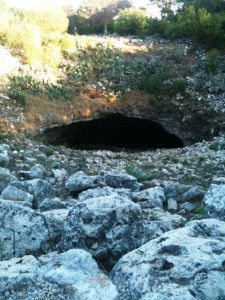 |
| Entrance to Bracken Cave |
Mines–the hole-in-the-ground kind–are rare in Texas. We have canyons that are green with copper, but not enough to mine. Plenty of rust-red dirt full of iron oxide. But not enough to mine. Along with all that oil, there’s quite a bit of coal. And in the 1800s and early 1900s, they did mine it in a crescent that runs along the Edwards Plateau. A few strip mines were dug in the 1950s-70s, but by now, all of those mines of whatever variety have been abandoned. Not enough coal to be profitable. There were also uranium mines, south and a little east of the coal mine region, but those were primarily surface mines. They’re abandoned, too. Now.
Thing is, many of those mines are more than just dangerous to fall into. They have gases, the kind that will kill you if you breathe them. So, when an author talks about a mine in Texas, I want a little more justification for using it than just the fact that it’s there. A little explanation about the historic coal mining. One sentence would have helped. Because historically, there just haven’t been that many, and I’d think the ones that are there would kill the bats. (Or maybe not. Their guano gives off gas, and they seem to breathe that just fine…)
It would have been so much easier just to use a cave. In the area where this book was apparently set, there are a whole lot of caves already, and most of them have bats. The cave in the picture, Bracken Cave, is the proud home of the largest colony of Mexican free-tailed bats in the state. (It’s in Comal County, home of New Braunfels, the Comal River and the original Schlitterbahn Water Park, not far north of San Antonio.) One more cave, private to those on the ranch, would have been a lot more reasonable to us Texans than a mine.
I will probably have more blogposts filled with tangential stuff. Like basements. I need to talk about basements sometime. And weather, as opposed to climate. And schools. And…
These posts aren’t meant to be comprehensive or definitive. I’m sharing what I know about Texas in hopes that it will help writers realize there’s more to Texas that what you see in movies or on TV (which is mostly California).
]]>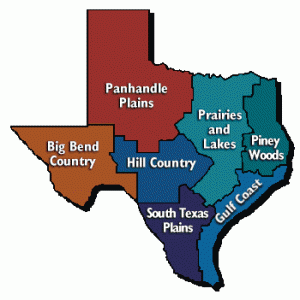
And we’re back to the “regions of Texas” graphic again. Today we are talking about the Prairies and Lakes, or Crosstimbers region of the state of Texas. This area includes most of the central part of the state, up to the Oklahoma border. Some of it is North Texas. (Remember, North Texas is Dallas-Fort Worth north to the OK border–east and west as far as the Crosstimbers runs.) Some of it is Central Texas. A whole lot of Texas is in Central Texas, but like some of East Texas is in the Coastal Plain and most of it is in the Piney Woods, Central Texas can be in the Crosstimbers, the Hill Country, or parts of the Plains, whether northern or southern…
I lived in the Crosstimbers for about 20 years, so a lot of the pictures in this blogpost I took myself. Much of the territory is ranch country, and the among the prettiest ranch country in the state, in my not-so-humble opinion. The landscape is gently rolling hills with wide meadows crossed with bands of trees. The trees are not as tall as they get in East Texas. There are no pine trees, except down around Bastrop in the Lost Pines area–a good variety of hardwoods, plus nasty ol’ hackberry, mesquite and juniper–which everyone calls cedar or mountain cedar, but it isn’t cedar. It’s juniper. The juniper pollinates in midwinter and the people who are allergic really suffer then. I know of people who leave the state to avoid cedar fever, AKA juniper allergies.
 |
| Bluebonnets in a pasture outside Ellinger, TX |
The meadows are thick with wildflowers in most seasons of the year. Texas is one of the best places for wildflowers–I personally think every bucket list in existence should include coming to Texas during bluebonnet season–April to May, depending on what part of Texas you’re in. They are spectacular and almost unbelievable. The picture to the left was taken in 2012, when the winter rains had been decent.You can see the oaks and other trees on the far side of the pasture. This is a pretty typical landscape in the Crosstimbers, unless the meadow has been plowed up for row crops. Farther north, around Waco, cotton and grain sorghum grow really well in the black land prairie. You will note that the flowers are actually blue, not purpleish…
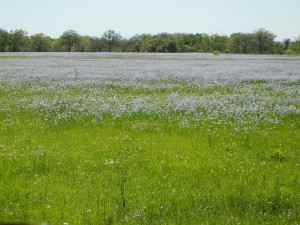 |
| Pasture outside La Grange, TX |
Texas is such a wildflower haven because 1) the winters are mild. Bluebonnets actually come up in the fall, grow all winter and then bloom in the spring. The mild winters help with that. 2) There’s a lot of sunshine in the meadows. The Piney Woods has all the shade flowers, and when the pine trees start to fade and the prairies and plains take over, the flowers just explode in the sunlight.
The flowers in this next picture are not bluebonnets. You will note that these are purple. They’re some kind of little tiny pea flower, about a half-inch in size with a sweet smell way out of proportion to their size. Oh, they did smell good!
Y’all can tell I really love Texas in the springtime. And again, the Crosstimbers Region isn’t desert. It’s prairies crossed by trees.
 Do y’all know the difference between a prairie and plains? Apparently, in a technical sense, there isn’t much of a difference. The Great Plains are prairies. But prairies are supposed to be areas where grass is the main vegetation, and in the Crosstimbers, the prairies and the woods alternate. And there are rolling hills. The hills can get quite high in this part of the state, but they’re not steep. The steepness of the hills in Pennsylvania startled me. I’m used to a much more gentle slope. The hills in the Texas Hill Country are steep–but they tend to be bare rock. The ones in the Crosstimbers have grass on them, mostly. As you move west through the area, the hills tend to get higher and steeper, more like mesas or bluffs.
Do y’all know the difference between a prairie and plains? Apparently, in a technical sense, there isn’t much of a difference. The Great Plains are prairies. But prairies are supposed to be areas where grass is the main vegetation, and in the Crosstimbers, the prairies and the woods alternate. And there are rolling hills. The hills can get quite high in this part of the state, but they’re not steep. The steepness of the hills in Pennsylvania startled me. I’m used to a much more gentle slope. The hills in the Texas Hill Country are steep–but they tend to be bare rock. The ones in the Crosstimbers have grass on them, mostly. As you move west through the area, the hills tend to get higher and steeper, more like mesas or bluffs.
Dallas, Fort Worth, and Austin are the major cities in the Crosstimbers region of the state. Waco, Temple, Killeen and Fort Hood are also in this central area of the state. Austin is right at the dividing line between the Crosstimbers and the Hill Country, so East Austin is more Prairie-like and the west side of the city is more hilly, with the white rock hills and great views and lots and lots and lots of juniper. Austin is death on people with juniper allergies.
There are lots of lakes in this area, some of them built for flood control, others for water supply. But every one of them is from a dammed-up river. There are lots of rivers in Texas, all of them–except for the Rio Grande which begins in New Mexico–both begin and end in Texas.
One thing you Easterners might not consider–because when I did it in a car with people from the Eastern US, they looked at me like I was crazy in the head–but I bet you Westerners do just like I do. Every Texan I’ve ever talked to does it, too.
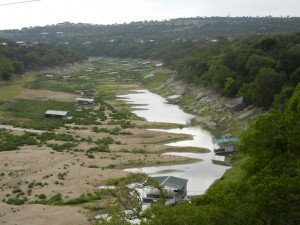 |
| Pedernales River, July 2011 |
Whenever I cross a bridge over a body of water, I look to see if there’s water in the river.
Because there might not be. Those Easterners looked at me funny because to them–well, of course there’s water in the river. Where else would it be?
Not there. When we crossed over the Pedernales River (pronounced “Perd’n-ALlis) on our way to Marble Falls in 2011, when we were having such an awful drought, there wasn’t. We had to stop and take pictures of all the boat docks sitting on dry land. One side of the bridge, the river had a few puddles. The other side didn’t have even that.
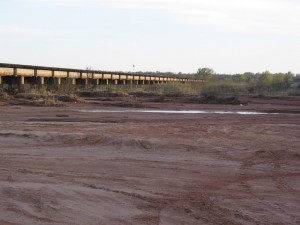 |
| Red River, outside Estelline, 2006 |
You might have heard it said about the Red River, “A mile wide and an inch deep.” That’s pretty much what it looks like. Folks like to go down to the bed of the river to ride their ATVs, because it’s mostly red sand. And nothing else. Maybe a trickle of water down the middle…
There’s usually a little more water in the river north of DFW than there is up in the panhandle sections, but it still looks pretty much the same. That’s the railroad trestle in the picture, not the highway. I think. Might be the road. Notice it’s not very high…
What else is there to tell you about the Crosstimbers? Not much, actually. It’s in the middle of the state. It has rolling hills and grass and very fertile soil. The blackland prairie is some of the most fertile soil in the world, and yes, the dirt is black. Literally black. When the inlaws drove past once, they thought the fields had been burnt. They hadn’t. West (where the explosion was) is in the blackland area. There, it’s kind of a waste to just raise cows on the land, because row crops will be so much more profitable, so there isn’t much in the way of ranches in the blackland. Waco is in the blackland prairie. Hillsboro, where I-35 splits, is in the blackland. Another name for it is black gumbo clay, meaning it’s thick and gooey and slips and slides around. So if you’re in the blackland, you have to make sure your house is extra stabilized. Lots of foundation issues, because the soil swells and moves so much. In Hill County, (where Hillsboro is the county seat) the eastern end of the county is blackland–lots and lots of cotton, not so much cows. But about 8 miles west of Hillsboro, toward Whitney where I used to live, the blackland fades away to more sandy soil and white rocks. The western end of the county is full of ranches and a few watermelon patches.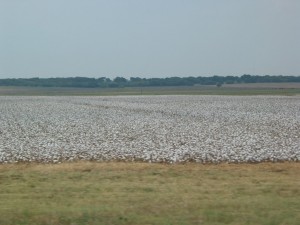
I can’t get the stupid picture of the cotton field to go where I want it to. Grr. I just thought it might be edifying for folks who don’t live where cotton grows to see it in the field. This was taken from a moving car, so…
It’s harvested with huge combines like wheat is, except they’re called cotton strippers, because they strip the cotton from the plant. When I worked for the Hill County Attorney we had a “Fleeing from police in a motor vehicle” case where the young man was running from the sheriff’s deputies in a cotton stripper. It didn’t go much more than 15 mph at top speed, but the sucker was so huge nobody wanted to try to stop it–at least 10 feet high, and as wide and long… It was pretty funny, actually. Oh, I do have stories from that job… However, that’s not what this blogpost is about.
I don’t know what else to tell you about this part of the state. Lots of hardwood trees. Pecan orchards. Oak trees. Lots of grass and meadows. Lots of row crops, but big ranches also. Depends on if the dirt is black or pale tan. The rocks tend to be mostly limestone. The sandstone crops up farther west. There are hills, mostly of the gently rolling variety. There are springs and artesian wells. A high water table. There are lots of rivers and man made lakes. To be honest, central Texas looks a lot like central Illinois or Ohio along the turnpike. Maybe a little browner in August. A whole lot bluer during bluebonnet season. But the landscape isn’t that different.
And once more, these blogposts are not anything like a comprehensive or complete description of Texas. I just want to get folks to realize that Texas is not what they might have seen in the movies (that’s most often California), nor is it all the same.
]]>Do I really have to go back to the distance thing? Really? Fort Hood is between Waco and Austin, wrapped around Killeen and Copperas Cove. Killeen is where they’re having the trial for the Fort Hood shooter guy. Or where all the reporters are staying, anyway. Copperas Cove is where Heisman Trophy winner Robert Griffin III (fellow Baylor Bear) is from. It is pretty close to Austin–maybe an hour’s drive away, and the same to Waco. (Waco is in that 200,000 population range, remember.) It is not close to Dallas. It’s over 2 hours’ drive away. More, if you have to drive through Dallas because your small town is north of the big city. Texas has a lot of big cities. Authors should take a look at a map and see which ones are near your mythical location. And maybe take a little look at the size of towns.
However, this blog is going to be about the Texas climate.
Most people understand that Texas is hot. But a lot of them don’t seem to realize just what that means. One thing it means is that summer lasts a really long time. My daughter grew up in central Texas. After her marriage, she and her husband both went to Carnegie-Mellon University in Pittsburgh–the one in Pennsylvania, not the one in East Texas–to earn their doctorate degrees. And every year in August she complained, because August was not the hottest month of the summer. It was already starting to cool off there in Pennsylvania, and that, according to her, is just wrong.
In Texas, August is unbearable. It’s the hot month. It’s the month those of us on the coast–and inland–really start watching for hurricanes. We just replenished all our hurricane supplies for this year.
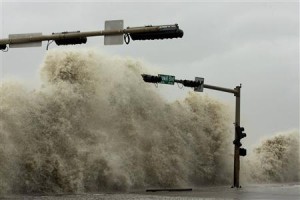 |
| Galveston seawall before Hurricane Ike |
Of course, living on the coast, we are wary of the hurricanes. When we lived in Whitney, north of Waco, we liked the hurricanes. We hoped one would come our way, especially during a drought. Remember the distance thing. Waco is over 200 miles from the coast–about 4 hours’ driving time. By the time a hurricane travels that distance, it’s basically a big rainstorm. A hurricane can break a persistent high pressure zone and drought. So all of the folks inland this year and in 2011, the year of the Bastrop fire and extreme drought, would really like to see a Category 1 or 2 hurricane.
That said, I want you all to realize that it’s still hot in September. I have lived in most parts of the state of Texas, including the northernmost. (The Panhandle is never called North Texas. It’s the Panhandle. North Texas is the Dallas-Fort Worth area east to Commerce, west to about Weatherford and north to the Oklahoma border.) The Panhandle has actual winter. The rest of Texas pretty much doesn’t. At least not more than a couple of weeks at a time. Anyway, even in the Panhandle, it’s still hot in September. Like over 90F/32C. And it doesn’t cool off until the first blue norther (not “northerner”) comes through. Anywhere in Texas. And most of those don’t barrel through until late September. Sept. 19 to 21–near the actual fall equinox–is the most common date. And they don’t cool it off much. It might drop the afternoon high in Amarillo to 60F/16C, but it will warm up again.
Fall doesn’t arrive gradually in Texas. It’s: hot, hot, hot, hot, hot, blue norther–really chilly–reasonable. Sort of. That first cold front sort of shocks fall into existence. And in the Panhandle, sometimes it was a real shocker. It might actually freeze overnight. And all the fruitless mulberry trees would lose their leaves at once. Whump. The back yards of the people with the trees would suddenly be ankle-deep leaves. There is a saying–not the one about “wait 10 minutes and the weather will change.” The saying I’m referring to is: “The only thing between Texas and the North Pole is a couple strands of barb-wire fence.” Which is true. Think about it. It’s Great Plains all the way from the Rio Grande through Canada to the ice pack. There are no mountains. No lakes, really. Maybe a mesa or two, but they tend to be isolated. So when those cold fronts start rolling south, there is nothing to block those winds. Hence the way fall arrives. All at once, riding on a blue norther. But it doesn’t stay cold. Or even chilly.
The nicest fall month in Texas is October. Usually the trees do not lose their leaves until November. They’re starting to sort of change in October, but usually, October is gorgeous. The temperatures are in the 70s. The sun is bright–I’ve had some bad sunburns in October because I don’t protect myself like I should. I forget that it’s still, well, the sun. And I’ll go to one of those afternoon Baylor football games and just blister.
One other thing you might want to be aware of: Most drinking water in Texas comes from lakes. It’s surface water. So in the summer, the water gets warm. When I was growing up, my brother always had an old soda bottle in the refrigerator filled with water. I always drank all mine up and forgot to refill it. Which is probably why I like room-temperature water better these days. Thing is–room temperature water is cooler than the water that comes out of the tap. Tap water in August is seriously warm. Especially in the more southern areas. In the Panhandle the water actually gets cold in the winter and warmish in the summer. Outside the Panhandle, it gets cool in the winter and really warm in the summer. There are some springfed water systems, with cold water year round, but most places need more water than the springs can provide, hence the surface water sources. And even if it is ground water, keeping it in a water tower warms it up. So in the summer, making someone sit in a cold water bath isn’t a punishment. It’s pretty pleasant, actually.
The first trees start blooming in February, when the redbuds break out.That’s when spring starts, essentially. The temps start reaching 80F/27C and 90F/32C by April and May. If it stays below 95F/35C all the way to the end of May, it’s been a cool spring. But really, Texas spring is more like summer elsewhere. Hotter than summers elsewhere. And winter tends to be sporadic.
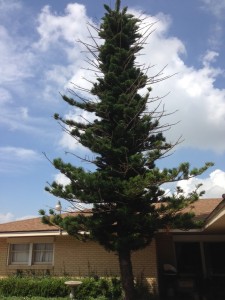 |
| Norfolk Island pine in my backyard |
Except in the Panhandle, what Texans experience as winter more northern states would not recognize. Any part of the state can experience a freeze. They’re extremely rare in the lower Rio Grande Valley–hence all the orange and grapefruit trees. But they can happen. My Norfolk Island pine in the back yard currently looks terrible because two years ago, we had a hard freeze that lasted most of a week. It killed the Norfolk pine at the Boy Scout office near my house, but ours survived, probably because it’s so big. (I took the pic of it, but had trouble e-mailing it to myself. Sigh.) Usually, a freeze in Galveston isn’t more than overnight. I mentioned driving through a howling blizzard between Lubbock and Amarillo. That is not unusual in the Panhandle. But once it passes, things warm up. In our little Panhandle town, our house faced south. I had pansies blooming all winter in my front flowerbed. And ice coating the patio all winter on the north side because it never got any sun. Downstate, ice storms are more common. Maybe once in the average winter in North Texas. Once every winter or two, or three, in Central Texas.
 |
| Prickly pear after an ice storm |
But. It doesn’t stay cold. There was one year when our kids were little that we had invited the fella’s folks to our house for Christmas. But a hard freeze cold front rolled through two days before and froze our pipes. (Insulation tends to be laughable in much of Texas because it just doesn’t get that cold that often for that long. Our pipes were in the garage. Without much insulation.) So we went north to the in-laws’ house instead–they live between Dallas and Fort Worth. The day after Christmas, the fella and I went out shopping–I was wearing a new sweater I’d received as a gift, and I nearly boiled to death! The high that day was 80F/27C. So, four days difference, and the temperature went from 30F/-1C to 80F. That is a typical Texas winter.
You don’t know from week to week whether you will need a heavy coat or short sleeves. A blue norther can blow through any time from September to April, and it can snow any time from November through April, depending what part of the state you’re in. It snowed on election day two different years when we lived in Clarendon. Our youngest son’s last year of college at Texas A&M Galveston, he never wore anything but shorts and flip-flops. Galveston’s winter is much like San Francisco’s summer. And we’re only 1/3 of the way around the coastal bend…
 |
| Yes, MY orchid. One of them. Outside. |
So when you’re writing a story set in the fall, winter or spring, you can make the weather whatever you want, pretty much. As long as you remember it’s not going to stay that way. If it’s cold, it will warm up. If it’s warm, it will cool down. Rapidly, in all likelihood. But summer comes earlier and fall later than you might realize. I don’t bring my orchids inside until almost December. And they’re back outside by the end of February.
However, once it warms up, it stays hot. Yeah, the weather might change after 10 minutes, but it’s not going to stop being hot. A thunderstorm will actually make things hotter, once the rain stops. Because after, it’s so humid, the heat index goes up. And yes, just like wind chill is a real thing, heat index–which takes into account the humidity–is very real. Galveston Island does not get the extreme heat of much of the mainland, because the water in the Gulf keeps things cool. It’s never topped 100F/38C here, though it does get to 95F and 97F frequently. However, the humidity is so high–being surrounded by water–that the heat index is often over 100F.
Once upon a time, I refused to believe that my husband could tell when the temperature was over 100F/38C, until one record-setting summer when we were still in Whitney (just north of Waco). One of the newspapers ran a series on avoiding heat stroke, and I realized that 100F is a full degree above normal human body temperature. It’s hotter than we are. And once the outside temp is hotter than we are, we stop shedding heat and start taking it on. Yes, you really can feel the difference between 99F and 100F. Most people have sense enough to take precautions when it gets that hot. Heat is just as deadly as cold weather. But when it’s very humid and the weather is cooler, it’s easy to get heat stroke too, because the sweat the body uses to cool down doesn’t dry off and internal heat just builds up. The heat is something that can be used in stories.
In the Panhandle, where it’s dry, the high temp during the day will often push 100F/38C, and then drop 30 degrees or more overnight. It usually doesn’t drop more than 30 degrees unless a cold front is moving through, but it could. In the rest of the state, it usually doesn’t drop more than 20 degrees. In fact, air conditioning can’t cool much more than 20 degrees, so despite the setting, if it’s 100F/38C outside, it’s probably not going to get much better than 80F/27C inside. And if it was 100F yesterday afternoon in Dallas, it’s probably going to be 80F at dawn the next day. Unless that blue norther is moving in… On the coast, there isn’t that much change between the high and low temps. Galveston is rarely more than 9 degrees cooler in the morning than it was yesterday afternoon. Sometimes, it only drops 7 degrees, almost never as much as 10 degrees. Unless a cold front moves through. So that’s a thing that’s different from one part of the state to another. And it only gets warmer as you move farther south.
The daughter (the one formerly in Pennsylvania) now lives in Georgia, at about the same northerliness as Dallas. However, Georgia doesn’t seem to be as hot as Texas, and I’m not sure why. Yes, it’s hot, but it’s a gentler heat. Seems to be a more humid heat. And the temps don’t seem to get as high. I have my childrens’ towns plugged in to my weather app so I can see how hot it gets there–and the Georgia town is consistently cooler than the Texas cities. One reason might be the sun. Although I don’t know how the sun could be different–it sure seems like it is. My sister lived in Taiwan with her family for three years, and she said that although it was hot and humid there, the sun did not seem like so much of an enemy there. It didn’t beat down so hard, make things so much hotter. It does here.
I used to laugh at the cows in the pastures all crowded up in the shade of the mesquite trees. First of all, mesquites are crummy trees. They’re small, their leaves are thin and lacy and they don’t make much shade. And the cows will crowd up under them until there’s not a speck of shade left. I laughed–until one day, when I was still working at the makeshift county courthouse in Hillsboro, in Hill County, Texas, and the judge came by scouring up all the workers he could for a newspaper photo op. The 1890 courthouse had burnt down the night of New Year’s Day in 1992 and we were all housed in an old grocery storefront with plywood and chicken wire walls. I worked in that plywood and chicken wire office for 6 years until the restoration was completed.
 |
| Hill County Courthouse-with the flagpole |
Anyway, somebody was making a donation to rebuild the historic courthouse and the judge wanted some lookers-on in the picture. It was July or August, hot as blazes in the middle of the afternoon, not a cloud in the sky, and we had to walk the block from the Courthouse Annex to the courthouse square. Lordy, it was hot that day. But somehow, I found a tiny bit of space that was just a smidgen cooler–and when I looked around, I realized that we had all lined up in the shade of the flagpole. (They wouldn’t let us get under the big old pecan tree…) Just that little stripe of shade, and it was enough to give us some relief from the sun.
This is why there are so many white vehicles in Texas. White is measurably cooler than any other color, including light colors like silver. And I don’t know what idiot decided that all pickup truck interiors should be black or dark brown. Have you ever sat on black leather after the sun’s been bleeding in the windshield for 4 hours? Yikes! The fella just bought him a new pickup, and he couldn’t find any with a lighter colored interior. (He hasn’t driven a pickup in 12 or 14 years, but he didn’t like any of the sedans available. So he went back to a pickup.) (A red one. Go figure.)
Again, these blogposts do not intend to be in any way scientific or comprehensive in their discussion of Texas. I’m just trying to explain a little about how things really are here and encourage writers to research the things it might not occur to them to research. And I’m hoping maybe to take those naked facts that research often offers up and try to show how those facts actually feel. What they can mean when you have to live them. I hope it helps.
]]>
I decided to go south and west before going due west. Probably mostly because I currently live in the Texas Gulf Coast Plain. Actually, I live off the Texas coast on one of those barrier sandbar islands like they have along Georgia and the Carolinas.
I think a lot of folks who live outside of Texas tend to forget that Texas is on the U.S.’s third coast. It has one. A long one, nearly as long as Florida’s Gulf Coast. (Texas just doesn’t have a coast on the other side, like Florida’s Atlantic coast.)
The countryside along the Texas coast, from the Sabine River on the Louisiana border to the Rio Grande on the border with Mexico, is pretty much the same. It’s flat, swampy and bordered with barrier islands or peninsulas. Just north of Galveston Island is Bolivar Peninsula. South of Galveston is Surfside, a beach community on another peninsula, I think. Bolivar is in Galveston County, and the most direct route to Beaumont and Louisiana. Surfside is in Brazoria County, so I don’t know as much about it, but it’s where we went to the beach when I was in high school in Houston back in the early ’70s.
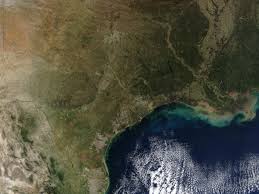 |
| The Texas coast from space |
Anyway, there are islands or peninsulas all the way south to Mexico. Padre Island extends all the way from Corpus Christi (about 2/3 of the way around the curve from Louisiana) to Brownsville (the city at the lower tip of the state). The coast is easily divided into thirds–Beaumont/Port Arthur/Orange is at the top, 1/3 of the way around is Galveston Bay, 2/3 is Corpus Christi Bay, and Brownsville is at the bottom.
Corpus Christi Bay is a deep bay. There’s a Navy base there, with ships and everything. The Houston Ship Channel runs through Galveston Bay. Ships line up in the Gulf waiting for a pilot to take them through Bolivar Pass between Galveston Island and Bolivar Peninsula and into the channel. The bay is very shallow.
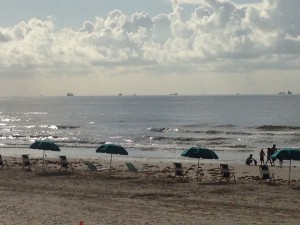 |
| See the ships waiting right on the horizon? |
I remember watching a documentary on San Francisco Bay that stated something about it being shallow, that it’s only 11 feet deep in places. And it made me laugh. People who have trouble with their speedboats in Galveston Bay don’t always have to wait for someone to come rescue them. Odds are good that they can just jump out of the boat and walk it in. Much of Galveston Bay is only 3 to 4 feet deep. This is why the Houston Ship Channel is so important, and the dredging of the channel is pretty much non-stop. It’s got to be deep enough to let these cargo ships through. And it’s why a pilot is required to get the ships–the ones that can make it–up the channel to dock. Because the channel and the bay are tricky. Some of the supertankers are too big to pass through the ship channel. They anchor a few miles off shore from Galveston and lighters come out to transfer the crude oil to the port facilities. Actually, all the ships anchor off shore, but most of them are waiting for a pilot. For their turn to go up the channel. Some of them just stay out there. I took the picture of the waiting ships this morning. There are always ships out there, just on the horizon.
 There’s a free ferry from Galveston to Bolivar run by the Texas Department of Transportation. TexDoT also runs a ferry at Port Aransas, just north of Corpus Christi, (There is no K in Aransas. It is not Arkansas misspelled. And it is pronounced Ah-RAN-zas) as well as the Galveston-Bolivar Ferry. There’s a bridge (toll) between Galveston and Surfside that crosses the San Luis Pass at the mouth of the Brazos River, and bridges between many of the other islands, and between the islands and the mainland. There has been talk of building a bridge across Bolivar Pass, but so far it hasn’t gone anywhere and probably won’t for a good while, because it’s a wide gap and because the bridge would have to be high enough for all those ships to pass. Cruise ships dock in Galveston, and they would have to get by any bridge as well.
There’s a free ferry from Galveston to Bolivar run by the Texas Department of Transportation. TexDoT also runs a ferry at Port Aransas, just north of Corpus Christi, (There is no K in Aransas. It is not Arkansas misspelled. And it is pronounced Ah-RAN-zas) as well as the Galveston-Bolivar Ferry. There’s a bridge (toll) between Galveston and Surfside that crosses the San Luis Pass at the mouth of the Brazos River, and bridges between many of the other islands, and between the islands and the mainland. There has been talk of building a bridge across Bolivar Pass, but so far it hasn’t gone anywhere and probably won’t for a good while, because it’s a wide gap and because the bridge would have to be high enough for all those ships to pass. Cruise ships dock in Galveston, and they would have to get by any bridge as well.
The ferries are all named after various TEXDOT heads, and painted the colors of the university they went to. The one in the picture is orange, because obviously that namesake went to University of Texas. There’s one painted maroon (for Texas A&M) and one painted green and gold (for Baylor University). I think one of the Galveston-Bolivar ferries is painted bright red, but I’m not sure where that namesake went. I don’t remember if it’s red and white (for Oklahoma, maybe?) or red and black (for Texas Tech).
The ferry is a great activity for Galveston visitors because, 1) it’s free, and 2) it’s one of the best places to see local wildlife, from brown pelicans to laughing gulls to Atlantic bottlenose dolphins. Even better, you can park and walk on the ferry for a ride over and back, and not have to mess with traffic waiting to get their car on board. I’ve seen lots and lots of dolphins from the ferry–more than I saw on the “dolphin watch” cruise… Brown pelicans have made a tremendous comeback since I was a child. I never saw one back in the ’60s or ’70s. Ever. But I see them every day now. In large numbers. When a pelican catches a fish, sometimes seagulls will land on top of it and peck it on the head to try to make it drop the fish. I didn’t believe it the first time I heard that, until I saw a gull actually do it. They do make you feed the gulls from the back of the ferry though, so they don’t get in the way…
 |
| Live oak with Spanish moss and palmetto |
The coastal plain extends at least two counties in from the coast. All of that territory is extremely flat, not very much above sea level. Houston’s elevation is 43 feet. Galveston’s is around 11, overall. Corpus Christi’s elevation is 7 feet. You can see why a hurricane could be a problem. This is one of the areas in the U.S. where rice can be grown. (Rice University in Houston is not named for the grain. It’s named after William Marsh Rice who founded and financed it.) The climate is warm and moist, and there’s usually plenty of water for flooding the rice paddies. Unless there’s a drought. Because the climate is usually pretty wet and the plants are adapted to all that moisture, a drought can cause problems faster along the coast.
The big cities are at those 1/3 markings. In between, the cities tend to be pretty small. Lake Jackson, Wharton, Victoria, and Kingsville are the larger of the small cities on the coastal plain. Lake Jackson has a bunch of other towns crowded together with it–Freeport and Clute among them. It prospers because there’s a huge Dow Chemical plant there. (The largest in the US, I think. My son’s a safety engineer there.) Wharton, Victoria, and Kingsville are towns that grew from their agricultural roots. The areas around them are pretty rural. Wharton’s less than 10,000 population. Victoria’s just over 60,000 (which makes it bigger than Galveston. Galveston was around 58,000 before Hurricane Ike, and is around 48,000 now, 5 years after Ike.) Kingsville is about 25,000, and Lake Jackson is about the same size. (This doesn’t count Freeport or Clute, but Lake Jackson is where the upper middle class folks tend to live.)
There are lots of waterways and bridges along the coast. My youngest son lives in Brazoria County, about an hour’s drive south of Galveston, depending on whether you take the Blue Water Highway down the island and over the San Luis Pass bridge to Surfside and across the bridge to the mainland at Freeport, or you go down the Farm to Market Roads on the mainland. Taking the mainland drive, we cross at least five bridges. Some have a high arch to allow boats to pass underneath. These are not rivers. Most are bayous or some other bay inlet. Oh, and in Texas, bayou is not pronounced “bye-yoo” as in Linda Ronstadt’s “Blue Bayou.” In Texas, it’s properly pronounced “bye-yo” (rhymes with yo-yo). Houston is on the Buffalo Bye-yo.
Along the coast, the live oaks tend to drip Spanish moss. The farther south you go, the more palmettos you’ll find growing. And those sawtooth palmettos you find in Florida and at the nurseries? Native Texas palmettos don’t have those sawtoothed edges. They’re smooth along the edge. So they won’t hurt you when you walk among them. Smack you in the face, yes, but not hurt you. Mexican fan palms are basically native and grow all along the coast, and you can plant and grow most other varieties of palms. A neighbor has some variety of date palm (probably non-edible, except by birds) that fall all over the street in late summer. The entire Texas Gulf Coast is in growing zone 9, with the very coastal edges in zone 9b (if that means anything to you), and the lower Rio Grande Valley in zone 10, where they grow oranges and Texas Ruby Red grapefruit. Basically, what this means is that semi-tropical plants will grow there. Bougainvillea, poinsettia, oleander, hibiscus, that sort of thing.
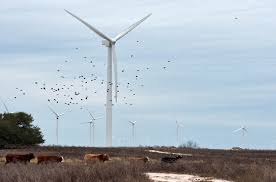 There are quite a few ranches along the Gulf Coast–in fact the King Ranch, one of the largest in the state, is on the coast between Corpus Christi and Brownsville. Before developers bought up all the ranch land on the island, there were ranches on Galveston Island. The cows thrived on the salt grass growing there. There are still cows and horses on the island, but they’re in smaller pastures, stuck in between beach houses on stilts. And they suffer in the hurricanes, though the owners do their best to get them off the islands, at least, for the hurricanes. It would be an interesting twist, I think, to set a Texas story on a ranch along the coast, and have palm trees, Spanish moss and all the rest of it…
There are quite a few ranches along the Gulf Coast–in fact the King Ranch, one of the largest in the state, is on the coast between Corpus Christi and Brownsville. Before developers bought up all the ranch land on the island, there were ranches on Galveston Island. The cows thrived on the salt grass growing there. There are still cows and horses on the island, but they’re in smaller pastures, stuck in between beach houses on stilts. And they suffer in the hurricanes, though the owners do their best to get them off the islands, at least, for the hurricanes. It would be an interesting twist, I think, to set a Texas story on a ranch along the coast, and have palm trees, Spanish moss and all the rest of it…
Oh. Pretty much all the beach houses are on stilts. Even the ginormous mansions. It’s pretty amazing to see these huge houses sitting up in the air with garages and nothing underneath them. I’ve seen houses that looked like something out of Arabian Knights perched up above a big garage. Even the hotels are–basically–on stilts. Sometimes, they’ll build up the earth under the foundation, or build big cement pilings and put the parking garage under there, but they’re all elevated. So if your story has your characters going to South Padre Island or some beach house–they need to climb stairs or ride an elevator or something to get to the main floor. Remember those hurricanes? Because on the Gulf Coast–from Florida through Alabama, Mississippi, Louisiana to Texas–it’s not a matter of if the hurricane will come. It’s a matter of when.
What else is there to say? What do you want to know?
I’m not writing a definitive description of the State of Texas. I’m just hoping to bring up things about the state that writers ought to know, and point them in the direction of a little research that ought to be done.
]]>